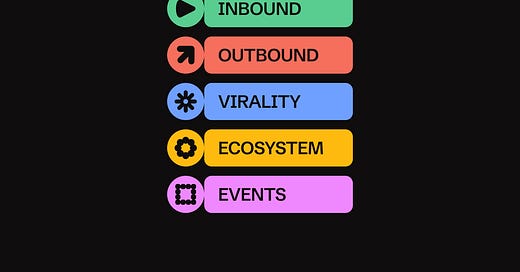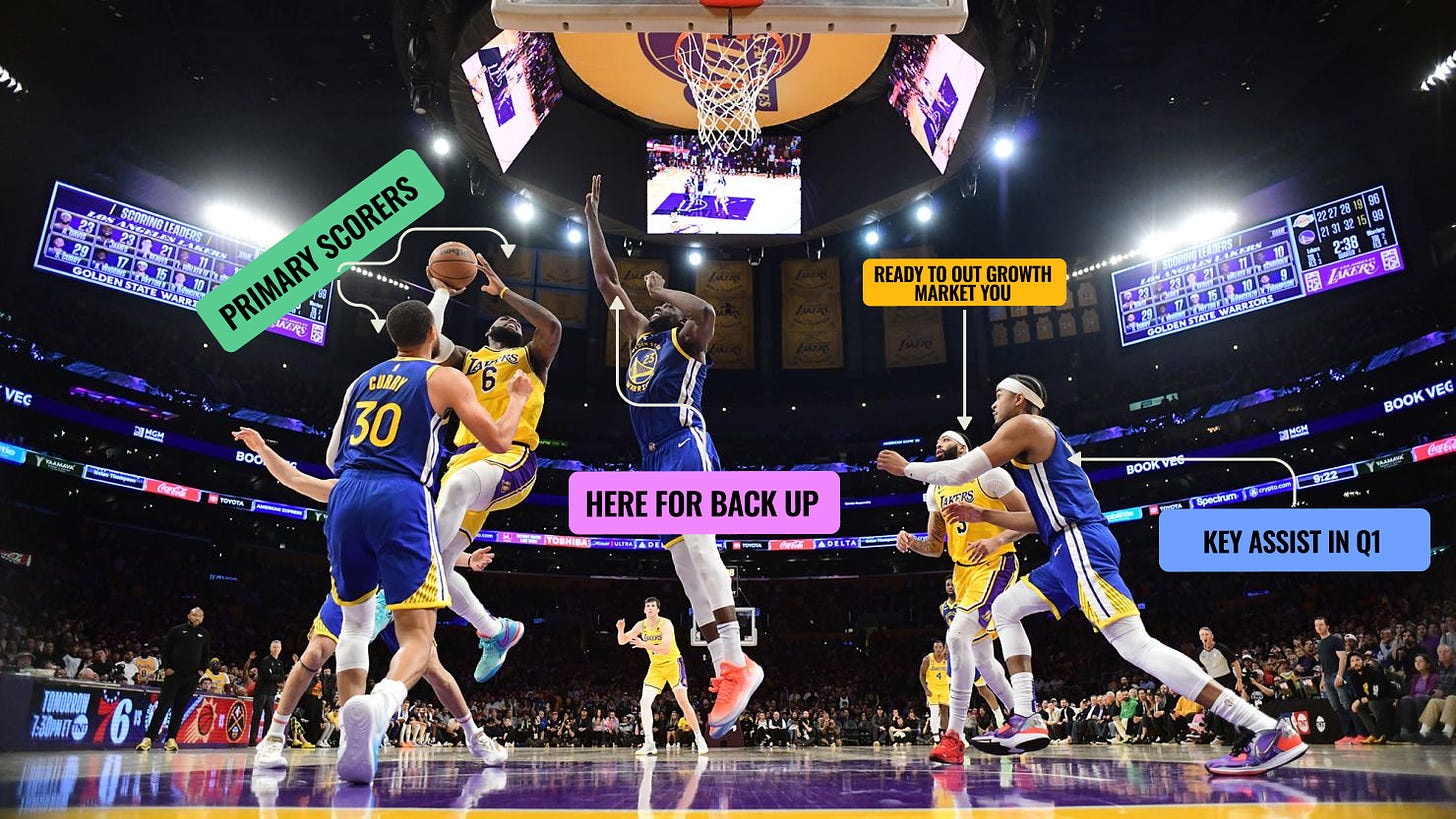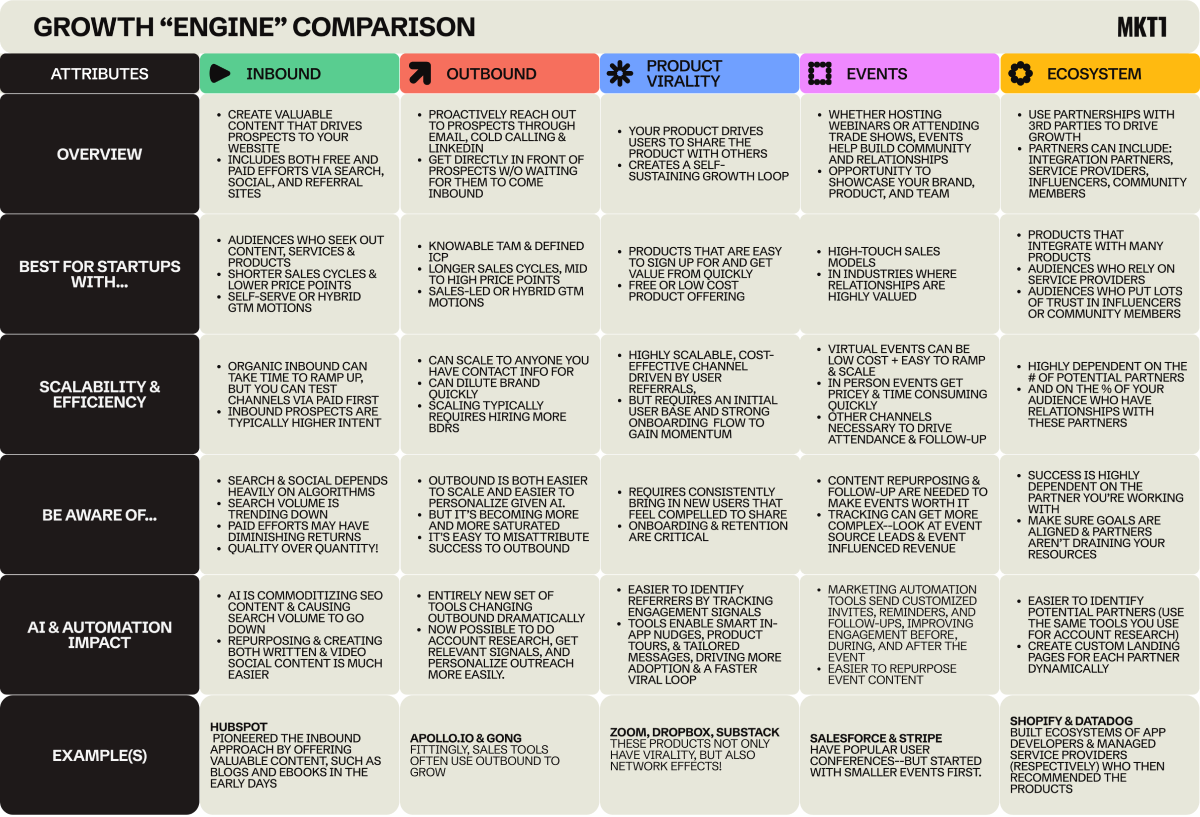👋 This is a monthly free edition of MKT1 Newsletter—a deep dive into a B2B startup marketing topic, brought to you by Navattic, RevenueHero & Ten Speed. Become a paid subscriber to receive an additional newsletter each month, access our archives, post to our job board, access our list of discounts, and use our template library.
There’s a myth that circulates through the startup halls—across newsletters, podcasts, panels, VC chats, LinkedIn: “Most successful startups use 1 primary channel to drive growth.” I’d argue this is a misleading oversimplification. See the debate here on LI.
I believe it only seems this way. I think this myth is primarily driven by crappy attribution, revisionist history, the desire for clean sound bites on startup growth, a few outlier companies where this was actually the case, and a misunderstanding of marketing. It’s simply not what I’ve seen when I’ve gone deep under the hood at startups.
In my experience, one channel won’t get the job done. You need to approach growth strategy like building a basketball team (excuse the sports metaphor). The players are your growth channels and you need to assemble a basketball team of channels to drive revenue growth most effectively. The highest-scoring player might get most of the credit, but there’s always more to the story–the player leading in assists, the player that got all the rebounds, etc. Basketball teams need to be ready for one player to get injured or to make a trade.
In marketing, you need to be prepared too: some channels may not work for every audience segment, some channels may see diminishing returns as you scale, and others may stop working entirely.
No, I’m not advocating you lose focus and try 5 channels at once. You need to pick channels that are a fit for your startup–based on your specific strategy inputs (especially your audience & marketing). You need to continue to test, scale, and optimize multiple channels over a startup’s lifetime.
That said, I never recommend relying too heavily on one channel. Layering multiple channels together over time is the most defensible strategy, especially as “engines” and channels are changing rapidly due to AI and automation.
In this newsletter…
This newsletter covers how to choose the right “engines” aka high-level growth channels–and how to use them together to maximize impact.
Overview of the 5 top-of-funnel growth engines: Inbound, Outbound, Product Virality, Events, and Ecosystem.
Which engines are the best fit for which types of startups
How to layer in other channels to create an even more efficient and effective growth machine, with examples
Mistakes to avoid and how these engines are evolving given AI & automation
Recommended products and agencies
We only include sponsors we’d recommend personally to our community and copy is in Kramer’s words. If you are interested in sponsoring our newsletter, email us at sponsorships@mkt1.co.
Navattic: Embed no-code interactive demos across web, emails, in product, etc. These demos work—Navattic customers see increases up to 450% on self-serve trials and 175% from free to paid.
___
RevenueHero makes it easy for your prospects to schedule meetings with your reps from inbound and outbound campaigns. RevenueHero’s customers convert~85% of demo requests into booked meetings!
Get 15% OFF if your company buys before November 30th.
___
Ten Speed partners with startups (including my advisees) on organic growth, full-service SEO & content marketing. They recognize that growth isn’t one-size-fits-all and build plans specific to your goals & ICPs.
Mention MKT1 to get $1,000 off your first month.
Section 1: Choosing the right engine(s)
I use 5 engine buckets to categorize all of the top-of-funnel growth channels available: inbound, outbound, product virality, events, and ecosystem. You may use different buckets, but I’ve found this is the easiest way to group things! Most of these engines have both organic methods (owned and/or earned) and paid methods, but that’s a whole other newsletter!
Note: This list does not include Lifecycle Marketing, which is another viable growth channel, but not for top of funnel (unless you use it to drive virality).
Comparison table of growth engines
This table gives you an overview of how I define each “engine”, what startup each is best-suited for, caveats for each, and how these engines are changing due to AI and automation, plus examples.
For a deeper dive into each growth "engine”, scroll on down to Section 3 and you’ll find more details than you probably want on each (I went a bit overboard…as usual).
Section 2: Channel pairings
While you may have a primary engine, combining engines and channels that reinforce and accelerate each other is the safest and most viable path to startup growth—especially given the speed at which marketing is changing due to modern tools and how prospects consume information and buy products.
Review this list of 10 pairings to find the engine pairing equivalent of peanut butter and jelly, salsa and guac, wine and cheese, beer and pretzels, etc. for your startup (Yes, I’m hungry right now while on a flight somewhere over the middle of America):
🛝 Inbound & 📩 Outbound
Approach 1: Use inbound content to attract and nurture leads, then follow up with targeted outbound outreach to high-intent web visitors. For example, engage content visitors from SEO with email or LinkedIn outreach to provide a more personalized experience and push them toward a conversion.
Approach 2: Use outbound to reach your top-tier accounts that you’ve co-identified with sales as part of an ABM (account-based marketing strategy) and rely on inbound for SMB & MM prospects.
Common mistakes: Lack of integration between inbound and outbound efforts (especially when siloed in marketing and sales respectively) can confuse and annoy leads.
Example - Snowflake: Snowflake has a highly-talked about ABM program: they identify key accounts and engage them with personalized outbound campaigns. But, they also spend a lot of energy on inbound content—especially for smaller accounts—including technical blogs on topics like certification preparation, data migration, and best practices, along with educational resources including instructor-led classes and on-demand courses.
🛝 Inbound & 🦠 Product Virality
Approach: Use inbound content to drive initial interest, then leverage viral product features to encourage users to invite others.
Common mistakes: You can overspend (both time & money) on organic and paid inbound, thinking product virality when you haven’t yet proved that at scale. So make sure you also focus on in-product growth tactics to drive adoption, retention and clear viral loops.
Example - Dropbox. Dropbox attracted users through inbound content and incentivized them to refer others with their famous referral program.
🛝 Inbound & 📅 Events
Approach: When users come inbound, especially if you have a sales-led GTM motion, offer a “shallower” conversion event in the form of a webinar showing the product without requiring a 1:1 meeting. You can also use webinars as CTAs on content.
Common mistakes: If you have too many CTAs on your website, visitors might get confused. You can even cannibalize high-value conversions by adding an event link when people might have been ready to purchase or request a meeting. My rule of thumb: leave the homepage hero focus on your primary CTA, add event links to landing pages and below the fold.
Example: Ahrefs is known for their inbound & SEO strategy, which makes sense given they are a product for SEO. But, they also use events. Their blog and YouTube channel have high-quality educational content (that I often refer to), and once these leads visit their site they often get invited to webinars and events (like this one). These events show off advanced product features and real-world use cases.
🛝 Inbound & 🪸 Ecosystem
Approach: Create content with partners, and amplify by sharing on each other’s social channels.
Approach 1 : Referral traffic is at the intersection of inbound and ecosystem. So you can do interviews, case studies, webinars, etc with partners that will be posted on their sites. You’ll reach their audience, and link them over to your site driving more inbound.
Approach 2: You can reverse approach 1 too, and use partners, guests, and influencers in your content so they share it on social naturally.
Common mistakes: Before partnering, make sure the companies or individuals you partner with are capable of upholding their end of the deal, have similar ICPS, and have similar brand values and quality standards. Another mistake: thinking partners will automatically share any content you create together. Make sure that’s part of the upfront alignment conversations!
Example: Zapier creates programmatic SEO content for every integration pairing on their site (think Asana + Google Docs) and often the featured startups link to this on their integrations page (if they don’t offer a native integration) or even share this content with their users to help them get more value out of their product.
📩 Outbound & 🦠 Product Virality
Approach: Use outbound to reach out to large accounts who you think will drive high product virality. Offer them a trial to help them land and then use lifecycle marketing to help expand within their organization–and beyond with partners and their ecosystem.
Common mistakes: Dedicating headcount to the outbound portion of this, without having a product that’s actually viral! Make sure you finesse the product’s viral loops and ability to get companies to land and expand without doubling down on expensive top-of-funnel efforts here.
Example: Zoom is an extremely viral product, with a network effect that makes the product more valuable with each new user. But instead of relying on this alone, they use outbound to reach enterprises and drive expansion.
📩 Outbound & 📅 Events
Approach: Reach out to specific accounts via outbound email and invite them to events–whether webinars hosted by you or side events at major conferences. This helps both channels be more successful. Outbound is best when you can offer something valuable (beyond just asking for a 1:1 meeting right away) and events are only worthwhile if you get the right people there.
Common mistakes: Overloading leads with event invitations–especially when the events or interactions are of low quality. Make sure you invite top prospects to events that are great!
Example: Gong targets B2B sales leaders through personalized, data-driven outbound, but instead of always using a 1:1 meeting with sales as a CTA, they use event registration as a lighteweight CTA.
📩 Outbound & 🪸 Ecosystem
Approach 1: Collaborate with ecosystem partners to identify target accounts and gain warm introductions, then follow up with outbound communication (or better yet have them do the outbound communication with you cc’ed).
Approach 2: You can use tools like Clay automatically enrich your list with technology stack data, allowing you to filter and target companies based on the tools they’re already using. (e.g., identifying companies that use Salesforce, HubSpot, or Stripe)
Common mistakes: Overloading ecosystem partners with demands, especially if you can’t deliver real value for these prospects.
Example: Segment connects customer data from many sources, so it makes tons of sense to use ecosystem to drive growth. Their outbound marketing targets companies looking to centralize data and references the tools prospects already use for easy integration.
🦠 Product Virality & 📅 Events
Approach 1: If your product has high virality (either within organizations or across organizations), invite users you think have a high likelihood to share your product to a customer event. Make them feel special so they are even more inclined to share!
Approach 2: Offer regular webinars for existing customers that show off your best features–espeically those that drive product virality.
Common mistakes: Pushing too hard on valuable customers to share. You want this process to feel natural so don’t overdo it, you dont want to lose that amazing customer.
Example: Notion invites high-value users to exclusive gatherings, which encourages them to share the product. (Note: I’ve never been invited, but I’m not offended as I’m team Asana + Google Docs). They also host regular webinars for users highlighting their collaborative features, which promotes sharing the product.
🦠 Product Virality & 🪸 Ecosystem
Approach: If a certain type of ecosystem partner (like service providers) are driving growth already, build a product experience that helps them manage their clients and their client’s use of the product. Imagine a dashboard consolidating accounting information for all of an accountant’s clients for instance. This drives a network effect, where every user can hep you acquire another ecosystem partner, and ecosystem partners in turn drive more customer growth.
Common mistakes: Often product and marketing teams spend so much time thinking about direct sales, they miss these opportunities to enable ecosystem growth. If you have network effect potential through your ecosystem partners, don’t sleep on it–it’s a super powerful combination.
Example: AngelList effectively connects startups and investors, and creates a network effect between all participants in the startup ecosystem. Startups can use AngelList to fundraise, those same investors can they use AngelList to manage their angel investing or fund portfolio.
📅 Events & 🪸 Ecosystem
Approach: Co-host events with ecosystem partners to attract broader audiences and leverage both networks. For instance, do a joint event for your shared audience with complementary products or host a panel with service providers that consult with your audience.
Common mistakes: Whenever doing anything with partners, you open yourself up to having misaligned goals, different quality bars, etc. Make sure you are aligned on what everyone will bring to the table in advance, before, during, and after the event.
Example: Mutiny, AudiencePlus, and Clearbit hosted a 3 city “Efficient Growth Tour” a couple years ago–as 3 startups at different stages they were able to share the burden of hosting these events, work together to get quality guest speakers, and drive greater attendance then they could alone.
More from MKT1
🙏 Thanks again to our sponsors: Navattic - Create & embed no-code interactive demos across channels; RevenueHero - Add meeting schedule with reps from campaigns; Ten Speed - Agency partner for organic growth, full-service SEO & content marketing. Mention MKT1 to RevenueHero & Ten Speed for a discount.
✂️ Templates for paid subscribers: Paid subscribers can find all growth marketing templates here.
👁️ Related newsletters: Anatomy of a marketing plan, How to choose the right channels for your startup, and Setting a marketing budget & tracking efficiency metrics
🧑🚀 Job board: Jobs from the MKT1 community. Paid subscribers can now add jobs to our job board for free.
📖 Keep reading: Paid subscribers get access to the rest of this newsletter—a deep dive into each marketing engine.






